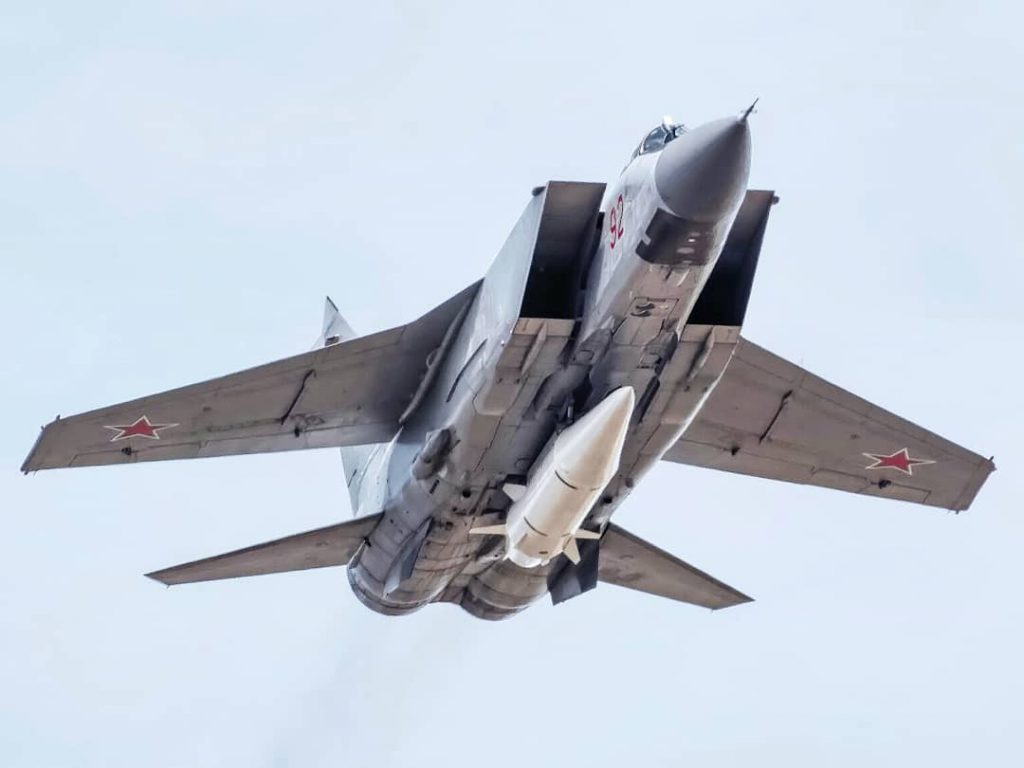SASC Pushes For More Hypersonics As Putin Flaunts New Weapons
Posted on

A Russian MiG-31 with a Kinzahl hypersonic missile.
WASHINGTON The Senate Armed Services Committee is joining its House counterpart in calling for a big boost in research on hypersonic weapons research and defenses against rapidly developing Russian and Chinese capabilities.
The SASC markup of the 2019 defense authorization bill calls on the director of the Missile Defense Agency to speed work on hypersonic defenses, adding $73 million for space-based sensors to track the objects hurtling through space at up to 10 times the speed of sound.
Elsewhere in the markup, the lawmakers add almost $200 million to other accounts for hypersonic development and testing, as they rush to push though projects that Pentagon leaders say have fallen behind recent developments being made by the Russians and Chinese.
On the defense side, the director of the Missile Defense Agency, Lt. Gen. Samuel Greaves, told Congress earlier this year that space-based sensors are “absolutely critical for the real threat that we see in front of us, the hypersonic threat,” and Gen. John Hyten, head of Strategic Command, warned, “we don’t have any defense that could deny the employment of such a weapon against us.”
Just a day after the SASC published its mark, Russian President Vladimir Putin announced that Moscow had already deployed one hypersonic cruise missile and said another will be deployed next year.
The announcement, made during Putin’s annual question and answer session on live TV, came three months after the Russian leader first said development of the weapons was advancing quickly, firing a warning shot across Europe and the United States that the Russian hypersonic weapon programs were further along than many had thought.
“The Kinzhal airborne hypersonic system is a hypersonic missile that flies at a speed of Mach 10 and it is already operational in our army in the Southern Federal District,” Putin said Thursday. “If someone has come to have doubts about that, he should watch it: we specially demonstrated the launches of this missile.”
Another hypersonic weapon, the Avangard system, “is in the process of industrial production,” Putin said. “It has gone into serial production and we plan to deliver it to the Armed Forces in 2019.”
The Kinzhal has been designed as a way for Russian forces to be able to operate at some depth, and is meant to counter the protection thrown up by U.S. missile defense systems like THAAD which could not engage a MiG-31, allowing the aircraft to maneuver relatively close to its target before launch the missile, giving shorter-range defenses such as Patriot less time to react.
Some believe the Kinzhal will also be placed on the Su-57 fifth generation fighter. The first prototype flew in 2010, and earlier this year one of the planes was sent to Syria for two days of combat testing missions. Putin first spoke about the weapon during a March 1 speech, which was followed by a video showing the missile being launched by a MiG-31.
The Kinzhal, being an air-launched system, could be especially problematic for NATO planners. Moscow claims that it is capable of speeds up to Mach 10 with a range of 1,200 miles, and is maneuverable in flight.
However, it’s not clear if all of that is true. the Kinzhal — a modified version of the surface-launched Iskander rocket — still promises to be a formidable arrow in Moscow’s quiver, and if it lives up to the hype, could potentially ram through sophisticated NATO air defenses.
In April, the U.S. Air Force awarded Lockheed Martin a $928 million contract for a hypersonic cruise missile, which is slated to cover the “design, development, engineering, systems integration, test, logistics planning, and aircraft integration support of all the elements of a hypersonic, conventional, air-launched, stand-off weapon,” according to information released by the Air Force.
Subscribe to our newsletter
Promotions, new products and sales. Directly to your inbox.
